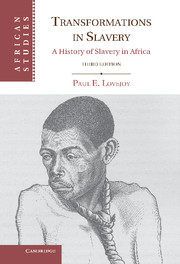Book contents
- Frontmatter
- Contents
- Maps and Tables
- Note on Currencies, Weights, and Measures
- Preface
- Preface to the Second Edition
- Preface to the Third Edition
- 1 Africa and Slavery
- 2 On the Frontiers of Islam, 1400–1600
- 3 The Export Trade in Slaves, 1600–1800
- 4 The Enslavement of Africans, 1600–1800
- 5 The Organization of Slave Marketing, 1600–1800
- 6 Relationships of Dependency, 1600–1800
- 7 The Nineteenth-Century Slave Trade
- 8 Slavery and “Legitimate Trade” on the West African Coast
- 9 Slavery in the Savanna during the Era of the Jihads
- 10 Slavery in Central, Southern, and Eastern Africa in the Nineteenth Century
- 11 The Abolitionist Impulse
- 12 Slavery in the Political Economy of Africa
- Epilogue
- Appendix Chronology of Measures against Slavery
- Notes
- Select Bibliography
- Index
- Books in this series
10 - Slavery in Central, Southern, and Eastern Africa in the Nineteenth Century
Published online by Cambridge University Press: 05 June 2012
- Frontmatter
- Contents
- Maps and Tables
- Note on Currencies, Weights, and Measures
- Preface
- Preface to the Second Edition
- Preface to the Third Edition
- 1 Africa and Slavery
- 2 On the Frontiers of Islam, 1400–1600
- 3 The Export Trade in Slaves, 1600–1800
- 4 The Enslavement of Africans, 1600–1800
- 5 The Organization of Slave Marketing, 1600–1800
- 6 Relationships of Dependency, 1600–1800
- 7 The Nineteenth-Century Slave Trade
- 8 Slavery and “Legitimate Trade” on the West African Coast
- 9 Slavery in the Savanna during the Era of the Jihads
- 10 Slavery in Central, Southern, and Eastern Africa in the Nineteenth Century
- 11 The Abolitionist Impulse
- 12 Slavery in the Political Economy of Africa
- Epilogue
- Appendix Chronology of Measures against Slavery
- Notes
- Select Bibliography
- Index
- Books in this series
Summary
The Expansion of the External Enclaves
In the eighteenth century, Europeans and their Euro-African descendants owned slaves at scattered points along the coast. The greatest concentrations were near Luanda, Cape Town, and the Zambezi valley. Despite the relative isolation of these holdings from the main developments in the institution of slavery in African societies before 1800, these European enclaves were the basis of a new order in central, southern, and eastern Africa in the nineteenth century. As these European enclaves expanded, a modified version of the slavery of the Americas expanded too. Despite the presence of a few plantations owned by Brazilians in Dahomey and Angola and the attempts at plantation development in Sierra Leone and elsewhere on the upper Guinea coast from the 1790s to the 1820s, slave masters in West Africa generally developed slavery into a productive system without the American example. Slave masters adapted the practices and traditions of their own societies – Akan, Yoruba, Igbo, or otherwise – so that European conceptions of slavery continued to be marginal, even as the economic importance of slavery increased. The situation in the southern third of the continent, therefore, was different from the experience of West Africa.
A parallel can be found in the adaptation of Islamic views of slavery in the northern savanna, where slavery was reinterpreted over the centuries in terms of Islam. The consolidation of slavery in the Muslim context represented an ongoing adjustment to the spread of Islam, the continued trade across the Sahara and the Red Sea, and the use of slaves in a variety of functions – the military, administration, domestic service, concubinage, and production. This kind of transformation had been largely absent along the Atlantic shores of Africa where Christian Europeans were present. In the nineteenth century, this situation changed.
- Type
- Chapter
- Information
- Transformations in SlaveryA History of Slavery in Africa, pp. 219 - 243Publisher: Cambridge University PressPrint publication year: 2011



